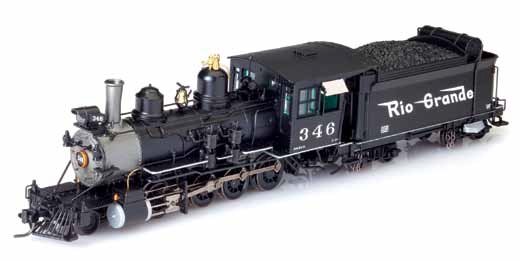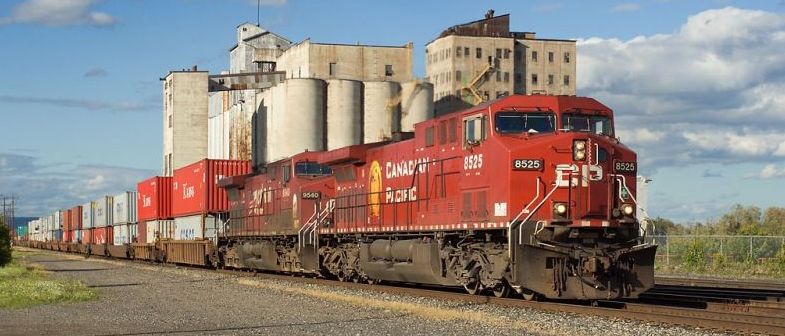SoundTraxx - HOn3 - Blackstone Models Steam C-19 2-8-0 Consolidation, w/Sound - Denver & Rio Grande Western No. 346 ('Post-Wreck', Flying Grande Herald) (1940-51/ in Colorado Railroad Museam) (SKU 678-310210-S)
Available On: July 1, 2013
'Post-Wreck', Flying Grande Herald, Road Pilot, “Post Wreck” Style Cab, Steam and Sand Domes, Pyle Headlight and Flared Tender with Sound
Narrow Gauge enthusiasts could argue that the 346 is among the most well known of the C-19 class locomotives. July of 1881 saw the arrival of Class 70 No. 406 and she was quickly assigned to the steep grades of Marshall Pass and all along the Gunnison Extension (Third Division) with the other Class 70 arrivals. The year 1903 saw the 406 heading south toward the San Juan Extension to Chama and the 4% grades of Cumbres Pass. The 406 also spent a little stint as the Durango switch engine. For the next 15 years 406 would be assigned sporadically all over the narrow gauge mainline (spending much time in Montrose) as well as being leased to the Rio Grande Southern on many occasions. The 406 was re-numbered 346 in July of 1924, and continued to serve the Colorado western slope narrow gauge country. Early in 1936, engine 346 was loaded onto a standard gauge flatcar and shipped out of narrow gauge country destined for the Colorado and Southern Railway in Denver along with sisters 343 and 345. Following a little modification with the addition of the C&S Ridgway cinder catcher, the 346 went to work between Denver and Leadville. The three leased C-19s were not particularly popular with C&S crews due to their propensity to derail. This problem was generally attributed to the non-flanged No. 2 and 3 drivers on the worn track conditions of the C&S narrow gauge line. Problems aside, the 2-8-0s were used extensively during their South Park tenure. Things went relatively smoothly for the 346 until July 25, 1936. On this day, the 346 was working as a helper out of Como on an eastbound freight. After cutting off from the rest of the train at the top of Kenosha Pass, the 346 headed east running light toward Denver. The engineer quickly lost control of the consolidation and the 346 overturned on a curve barely a mile below the summit. The engine suffered significant cosmetic damage, but even worse was the loss of the engineer that fateful day. After repairs in the Burlington/C&S Denver shops, 346 returned to the C&S rails sporting a new steel cab and a relatively odd looking steam dome cover and sand dome, as well as various other parts to replace those destroyed on Kenosha. No. 346 continued to serve the C&S until April of 1937, at which time she was again loaded up on a flatcar to head back home along with the 343 and 345. By 1941, the 346 wound up back in Durango and took on duties ranging from switch engine and occasional power for the Silverton branch, to sporadic forays on the Rio Grande Southern rails. After being purchased by the Montezuma Lumber Company in the spring of 1947, the worn engine faithfully eked out another year of service hauling lumber on a five-mile stretch between McPhee and Dolores, Colorado. A fire that destroyed the McPhee sawmill in early 1948 signaled the end of 346’s active career on the narrow gauge. After being stored with no future on a spur track in Dolores for nearly two years, the engine was rescued from the scrapper's torch by Robert W. Richardson. Thanks to Mr. Richardson and the efforts of many subsequent volunteers at the Colorado Railroad Museum, old 346 proudly steams today in Golden, Colorado much to the delight of the visiting throngs of railroad enthusiasts each year.
Features:
- Fluted sand and steam dome
- Prototypical Pyle headlight
- Wood panel style cab sides
- Two 9 ½ - inch single stage compressors
- Road style pilot
- Prototypical running board arrangement
?A Little C-19 History
From the late 1870s onward, the 2-8-0 wheel arrangement was no stranger to the narrow gauge Denver and Rio Grande Railway. However, one class of consolidation has the distinction of being the most powerful of all the 2-8-0s that were ordered from Baldwin Locomotive Works.
In the summer of 1881, twelve heavier consolidations arrived on the D&RG amidst a larger number of very similar, yet less powerful 2-8-0s. Numbered from 400 to 411 and designated as Class 70 (for approximately 70,000 pounds of weight), these locomotives found immediate use filling the power needs of the narrow gauge mainline from Salida to Gunnison via Marshall Pass. After faithfully serving the old Gunnison Division for a spell, five of these Class 70 engines were converted to standard gauge for use on wider rails in the 1890’s. These locomotives were converted back to narrow gauge by the turn of the century with a slight juxtaposition of their original road numbers. They continued to serve the railroad in various locations along the thriving narrow gauge. Around 1914, the Class 70 locomotives were fitted with new steel boilers in keeping with new laws enacted by the Interstate Commerce Commission concerning boiler safety. Along with these rebuilds came the appearance of longer, extended smokeboxes, electric headlights, and straight “shotgun” style smokestacks. This is the basic appearance that these venerable consolidations maintained for the rest of their service days. The D&RG re-organized as the Denver and Rio Grande Western in 1921, and in 1924 many locomotives were re-numbered in a motive power reclassification effort of the railroad. At this time, these ten remaining Class 70 engines became numbers 340-349 and were given a new designation of Class C-19.


$499.95 US



